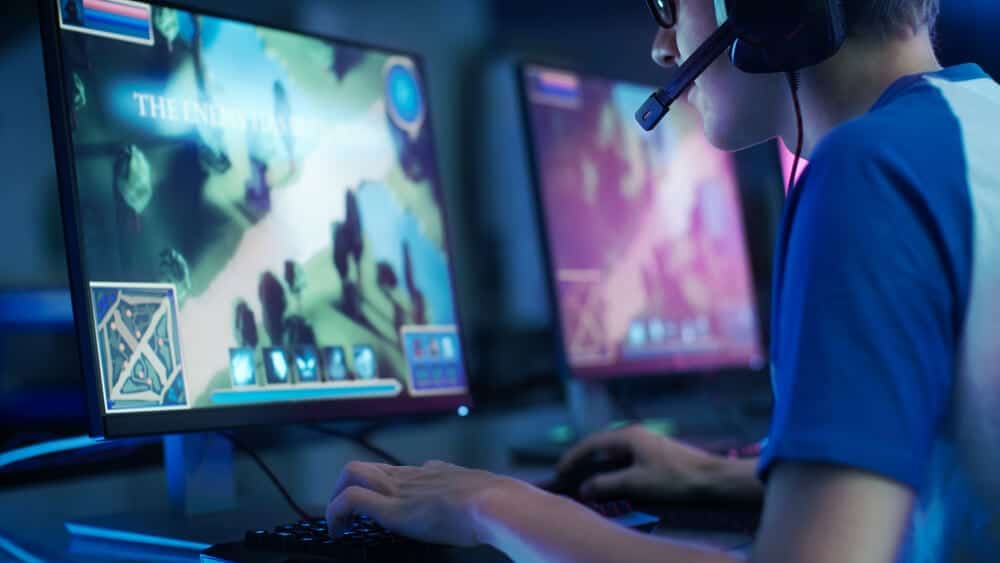
Your teen immediately escapes to his room as soon as he bursts through the door from school. Dropping his backpack, ignoring your questions, he can’t focus on anything but playing online with his “friends”. You peek in to see who he is talking to and realize that he is completely engrossed in the images flashing across the screen, excitedly shouting into his microphone. You call him for dinner and he tells you that he is not hungry; doesn’t have homework and will shower tomorrow. Day after day, hour after hour, he sits in his room, glued to what is apparently an engaging video game.
How long do you let him play? Who is he talking to? Is it safe? What kind of game is this? These are all legitimate fears, concerns, and questions for a parent whose teen is playing their favorite MMO and who may have a video game addiction.
MMO?
There are certainly some of you out there who may be wondering what in the world MMO stands for. You are not alone!!! According to Dictionary.com, an MMO is an online video game that can be played by a very large number of people simultaneously. In other words, a Massively Multiplayer Online game in which possibly hundreds to even thousands of gamers can join in simultaneously, all playing in the same game.
The video game industry itself is a massive revenue generator, earning over $148 billion globally by the end of 2019, with more than $35 billion from the U.S. alone. Financesonline.com estimates that this figure is comprised of 1.3 billion gamers worldwide! It has been calculated that $3.8 billion has been spent by the 46 million gamers in the United States on MMOs.
Now to most people it does not seem possible that thousands of people from every corner of the world could be playing together, competing, collaborating and helping each other. But it is true! In today’s highly digital world, a player can take on a persona or avatar and interact with others in a virtual world. Never meeting, never having any face to face contact, maybe not even knowing the person’s true identity.
However, MMO’s are very popular and can even lead to a video game addiction in some teens. Let’s look at just a few of the MMO’s that are commonly and frequently played to name just a few:
- Raid: Shadow Legends
- Taonga
- Forge of Empires
- Dragon Lord
- Elvenar
- Arche Age
- World of Warships
- Fortnight
- Overwatch
Video games have been a favorite past-time for teenagers for decades. From the arcades of the 80s which hosted games like Pacman and Tetris to the 2018 craze of Fortnight, both adults and young people alike remain engaged for hours on end inside these imaginary worlds. The risks, challenges, and escapades that present themselves digitally absolve the participant from physically taking any risks themselves, instead moving vicariously as their imaginary persona. Who wouldn’t want to live and play in someone else’s body if they didn’t have to worry about school, homework, chores, bills, and relationships!!
During adolescence, when teens are faced with forming their identities, struggling to develop relationships and to “fit in”, managing their hormonal changes, and adhering to social norms, the virtual world of an MMO is an appealing escape. They offer engaging, attractive, interesting scenarios in which the teen can easily succeed, improve their skills, and virtually never fail. Unlike in the “real world”, they may have superpowers to fight any opponent, combat any demon and be the hero of the game. For some, these feelings may fill a void in a developing teen that they have not been able to fill in their real lives.
Video game addiction
In recent years, gaming has transformed from simple entertainment to what could be considered an addiction. Because of the large number of teens who have succumbed to the addictive nature of the games, the American Medical Association has recently considered video game addiction to in fact be an addiction disorder. Although not yet classified in the Diagnostic and Statistical Manual of Mental Disorders, video game addiction can be identified as “an obsessive preoccupation with games at the expense of real-life activities or obligations.”
Many parents are now concerned whether their teen may fall into this category. While video games are not detrimental to their health in the same way drugs or alcohol are, a video game addiction is real. The immature, developing brain of a teenager is impacted in the same way. The function of playing video games releases a chemical into the brain, dopamine, which improves mood and provides a euphoric rush. This is the same chemical released when using and abusing drugs and alcohol.
How would a parent know if their teen’s favorite past-time has morphed into a video game addiction? Let’s look at several warning signs that would be an indicator that your teen may have a problem.
- Inability to set reasonable limits on how much time is being spent
- Using gaming as a means of escaping or avoiding real life
- Extreme desire to play at all times
- Preoccupation overrides household responsibilities or school work
- Decreased interest in other activities that once enjoyed such as sports, drama or extracurricular activities
- Neglect of personal hygiene
- Inability to control anger and irritability when forced to stop playing
- Physical symptoms may resemble substance withdrawal if the game is removed or taken away
- Avoidance of interpersonal connections and relationships, preferring instead the “relationships” established with other gamers
- “Flow” in which the gamer is so engrossed in the video game that they completely lose track of time
- Sleepless nights or restless sleep
- Migraines and constant headaches from the continuous eye and brain stimulation
- Stealing money or being deceptive to obtain games or to purchase subscriptions
While many of the signs and symptoms of video game addiction could also be typical of other types of mental health disorders or addictions, these symptoms will be very clearly related to and a repercussion of gaming. Video game addiction has been on the rise throughout the world in recent years. In fact, due to the very nature of gaming and MMO’s and their addictive properties, the government in China had instituted a 14-year ban on game console imports and sales in an attempt to prevent youth from developing video game addictions, only to be recently lifted.
Studies have shown that viral games like Fortnight, World of Warcraft and other MMO games with their enticing colors, avatars, skins, digital effects, and surprisingly real images, are like a carrot dangling on a stick in front of a teen. Teens become hooked on the exhilaration of the chase, the thrill of the kill, the excitement of the hunt, the drama of the search. With each win, the goal is moved slightly further out of their reach, enticing them to get to the next level, the next accomplishment or reward. With each advancement in the game and the level of competition, a teen continuously strives to beat the game yet in reality, as the game morphs and changes, “winning” always lies just out of reach.
Video game manufacturers intentionally want to keep the gamer “hooked” and therefore, continuously spending more money. While gaming engineers will admit that the games are meant to be immersive and engaging, what they really mean is that they want the player to be dependent upon the feelings that the games stir in them. Like the gambling addict who thinks that the next pull or roll is the “big one”, teens get sucked into believing that they will reach that next level, ultimately grasping the proverbial carrot. What’s not to like about these games anyway? They are fun, easy to learn and aesthetically stimulating.
Parents all over the world though are seeing the vicious hold that video game addiction has on their children.
- “My son stole my credit card and spent over $200 on the game.”
- In the U.K., a 9-year-old girl has been sent to rehab for Fornite addiction, after wetting herself to keep playing. When her parents removed the game, she attacked them.
- “Gaming is like heroin. Once you are hooked, it’s hard to get unhooked.”
- “My daughter sleeps fitfully and wakes up feeling exhausted.”
Harmful side-effects
Aside from the immediate rush of endorphins that teens feel as they maneuver through the imaginary worlds, constantly in search of the next battle or accomplishment, the physical effects of MMO gaming can have long-term and detrimental effects. When a teen sits for hours, engrossed in the game, losing track of time, their metabolism slows down. With each passing hour, the risk of obesity and more serious health issues increase. Blood flow decreases and with it the potential for blood clots, deep vein thrombosis, and heart disease.
As the desire takes hold and becomes stronger, in other words, addiction sets in, other areas of a teen’s life may begin to suffer. They may neglect their schoolwork, personal hygiene, and even neglect sleep to feed the need. Some teens may even experience problems with their hands and wrists, developing into Carpal Tunnel Syndrome. At what point is the gaming too much? When do you intervene, placing limits on playing time, encouraging social interaction? While these are all valid questions and the solution may not be pleasing to everyone, especially the gamer, there comes a point when the difficult decisions must be made.
If you suspect that your teen has a video game addiction, you should seek the professional advice of your child’s physician who will recommend an evaluation and possible treatment by a mental health professional like those at Beachside Treatment Center. Let’s look at several best practices that you may want to try in the meantime to attempt to divert your teen’s attention away from the allure of the MMO and back to reality.
- Allow gaming time every other day and for less than 2 hours at a time. Set a kitchen timer if necessary to bring them back to reality and to get unstuck from the “flow”.
- Create a requirement that homework and exercise occur before any gaming
- Remove all gaming devices including phones from the bedroom to prevent gaming versus sleeping
- Establish firm boundaries and guidelines and firmly stand by them
- Encourage relationships with “real” friends rather than only those who are also in the virtual world, many of whom they only know their screen name, rather than “real” name
- Establish a rule that there is no gaming first thing in the morning and devices must be shut down one hour before bedtime
- Encourage and facilitate participation in extracurricular activities such as sports, hobbies, music, and clubs

Even with the establishment of rules and boundaries, it may be next to impossible for a teen who is experiencing a video game addiction to break free from the stronghold that the games have over him. It may be time to get the proper diagnosis and treatment from a mental health professional. Beachside Treatment Center offers the assistance and guidance that teens need to face their struggles head-on and to maximize their quality of life. By understanding the addictive qualities of gaming and the impact that it has had on them, teens may be able to grasp how detrimental it has been on their brain and body, helping them down the road of long-term healing and health.
Treatment for video game addiction includes behavioral modification therapy which helps to change the teen’s thought patterns and obsessive habits revolving around gaming. Through group therapy, teens receive moral support and motivation to help them not only overcome their addiction but to develop relationships that had been avoided and lost because of their addiction.
Put an end to video game addiction today! Reach out to a trained professional and get the support, guidance, and treatment that your teen needs immediately. The mental health professionals at Beachside Treatment Center will help to get your teen back on the path toward reaching their goals of being a productive member of their families




